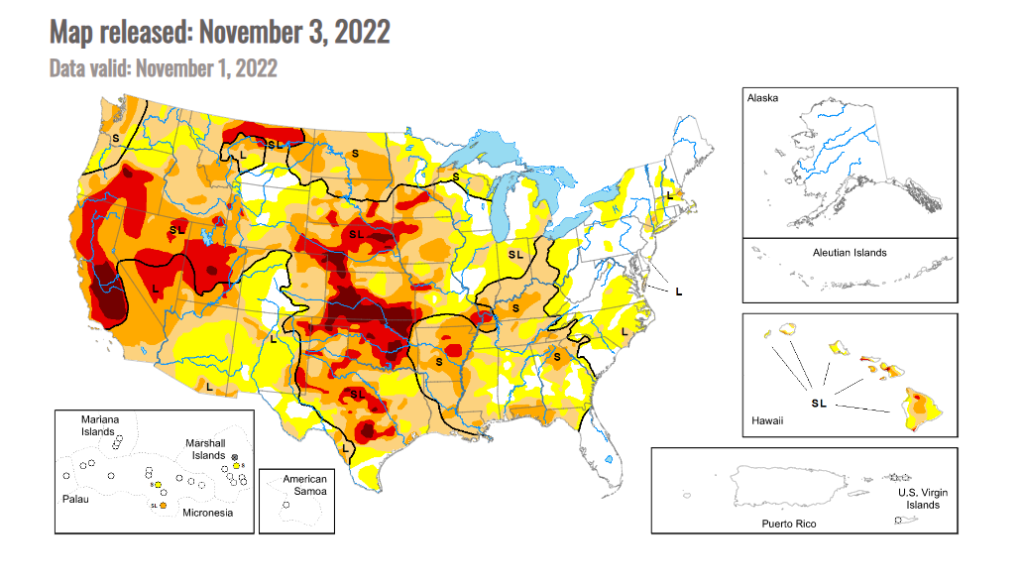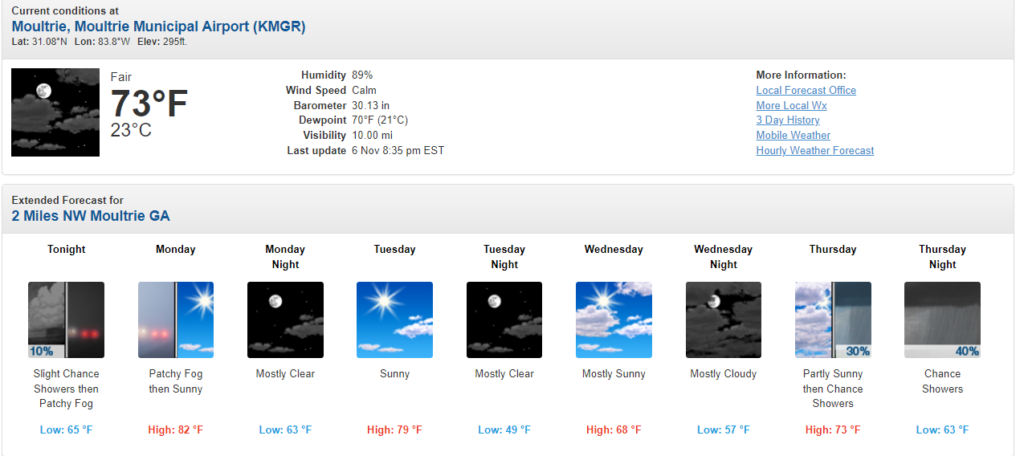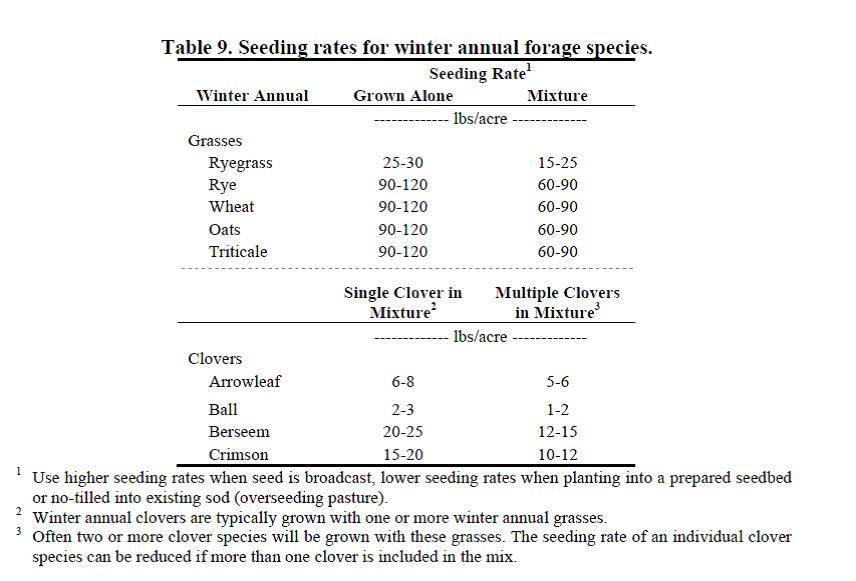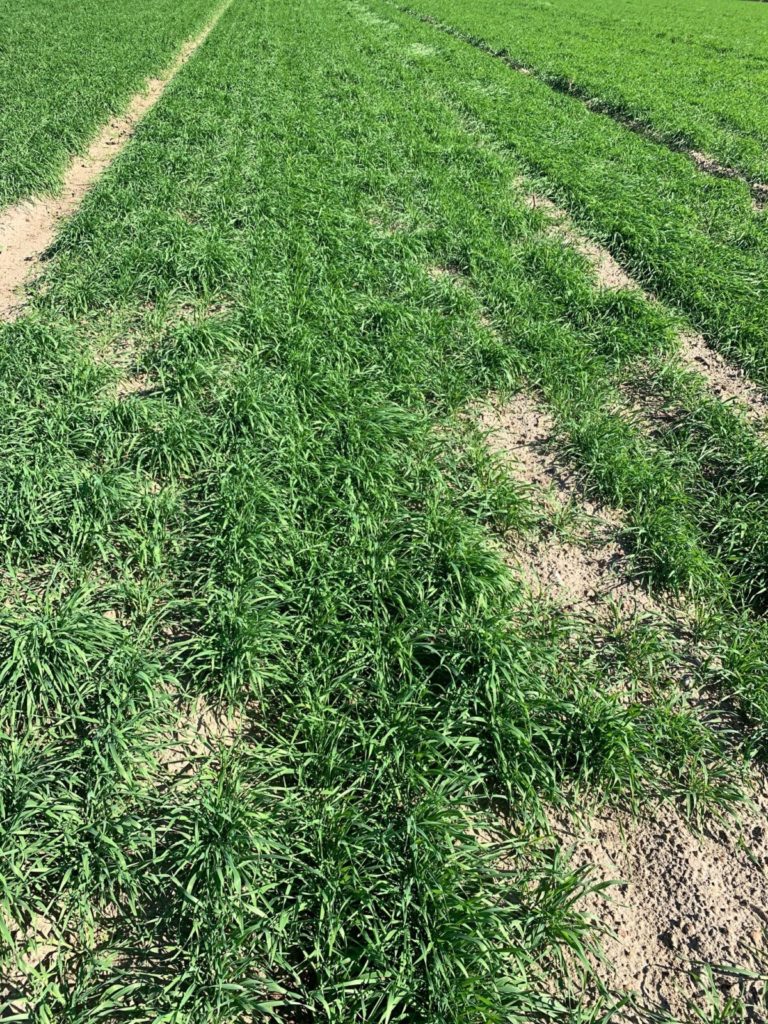Current Situation: Dry conditions continue in Colquitt County. According to the latest drought monitor, most parts of Colquitt County are considered abnormally dry, and the south east portion is considered to be in moderate drought. The dry weather is great for the cotton and peanut harvests. I have been hearing about better cotton yields from growers in the county. The dry weather is challenging cattlemen who are trying to establish winter annual forages. The latest drought monitor for Georgia is shown below.


What is the cotton defoliation recipe this week? The weather forecast for Moultrie is interesting this week. According to Weather.gov, highs are going to be in the 70s and lows in the 50s and 60s. Rain could be in the forecast toward the end of the week. The forecast for this week is below (11/6/22).

Below are a few words from Dr. Camp Hand, UGA Cotton Agronomist on the current cotton defoliation situation.
As I look at the forecast for the next little bit, it looks as if this week will likely be the last significant week of DD60 accumulation in our cotton crop. Put simply, good growing conditions will be hard to come by starting next week. Highs in the 60s and lows in the 30s-40s will hamper much further advancement in our crop. We need to start really considering how much farther we are going to ride it out. Some of the last stuff we have on the station will get defoliated tomorrow, just to try to get the most bang for our buck out of our defoliants. FYI, this stuff was planted June 16 and I would guess is probably around 30 to 40% open. Although that is what I am doing here in Tifton, I would still evaluate fields and situations on a case by case basis. There were a few fields I looked at last week where I told the agent to let it go as long as they could possibly stand. This was where there may have been one boll open per plant and it had a pretty good boll load on it.
Looks like we may have to dodge some showers in the middle of the week. Keep that in mind as you are determining what to spray. We haven’t had to deal with it much this year, but just as a reference Dropp has a rainfree period of 24 hrs. Mixed with other products it can be cut down to 12 hours, but that is still a long amount of time. I sent out a handy dandy two pager with the rainfree periods for some of our defoliants on it a while back, but if you need it again let me know.
As we get this late in the year, I get a little partial to Ginstar/Adios/Cutout products so we still have a little Dropp in the mix and it’s still active. However, we have a lot of options still. Higher rates of Folex can be used, as well as our PPO products (Aim, ET, Sharpen, Reviton, etc.). Make sure if you’re using a PPO product to read the label and utilize the appropriate surfactants.
Rates:
12 to 16 oz Folex + 42 oz Prep – Folex can be subbed for any of the aforementioned PPO products – Add dropp if there is significant growth in the top of the plant (I like to have it in the mix regardless)
8 oz Ginstar + 42 oz Prep – FYI, you can go with higher rates of Ginstar, but I would hold off on that until it gets pretty chilly
Mr. Kichler, Does wheat respond to deep tillage? Wheat responds well to deep tillage when hard pans are present in our soils, particularly sandy soils. Prepare soils for planting by first tilling with a V-ripper, chisel plow, paraplow or subsoiler. Firm the seed bed with a cultipacker or small, light disk to reduce deep ruts from planting. Till the soil only to a depth necessary to break the hard pan. Simple disking is not as effective as deep tillage but it is preferred over no-tilling wheat. No-till wheat can be productive
(mostly on heavy, clayey soils) but the yields, in general, are 5 to 25 bushels per acre less than
conventionally tilled wheat.
Soil test and apply all nutrients according to recommendations for high yield wheat…
Wheat should be planted in soils that have a pH of 6.0 to 6.5. If fertilizing for the wheat
crop only, apply all phosphorus and potassium in the fall during seed bed preparation according
to soil test recommendations. Nitrogen should be used in the fall to encourage tiller production
prior to the onset of winter. Tillers produced in the fall generally produce the most grain per unit
area (generally fall tillers account for 85% of the final yield). It is important though, not to
over-fertilize with nitrogen as it may cause excessive growth and result in winter injury. In
general, apply N (based on the previous crop rotation) as follows:
Cotton: 35 to 40 lbs ac
Corn: 30 to 35 lbs ac
Fallow: 25 to 30 lbs ac
Soybeans: 15 to 20 lbs ac
Peanuts: 0 to 10 lbs ac
NOTE: If using poultry litter, obtain a nutrient analysis so as to adjust the rate of
application according to the nutrient content. In general, 2 tons per acre is sufficient for
fall growth. Applying more may increase risk to excessive growth and winter injury.
Winter Annual Seeding Rates…This time of year I get a lot of questions about winter annual forage seeding rates. Selection of winter annual forages should be based on amount of forage needed, when the grazing is needed and seed costs. If you need earlier grazing then select a forage such as cereal rye. If grazing is needed later in spring then ryegrass is a great option. Clovers would be a great option for nitrogen fixation to help off set fertilizer costs. Keep in mind, clovers will limit your weed control options in these forage systems. Below is a table of seeding rates of winter annual forages and clovers.

Do we have any weed control options in winter annual forages? Yes, there are several options for weed control in winter annual forages. Options include 2,4-D, dicamba, Harmony Extra and other tankmix products. The information below is from the UGA Pest Management Handbook.
2,4-d and dicamba products need to be applied in December, January or February to control swinecress, blessed thistle, wild garlic, curly dock and similar winter weeds after small grain tillering but before jointing. Grazing restrictions may vary among the different 2,4-D products. Several 2,4-D labels restrict grazing for dairy animals or meat animals being finished for slaughter for 14 days after treatment. For Banvel, restrict grazing for lactating dairy animals for 7 days after treatment and remove meat animals
from treated areas 30 days prior to slaughter. For Banvel, there is no waiting period between treatment and grazing for non-lactating animals. Refer to specific herbicide label for additional use information.
Weedmaster is another option according to the pest management handbook. Apply to emerged broadleaf weeds when crop has 2–4 tillers. Do not graze lactating dairy animals within 7 days. There is no restriction between application and grazing for non-lactating animals. Do not cut for hay within 37 days after treatment. Do not graze meat animals in treated areas within 30 days of slaughter. Weedmaster and Outlaw will severely injure or kill clovers or alfalfa.
Harmony Extra is another option. Apply after two-leaf stage of wheat, barley, triticale and oats but prior to flag leaf being visible. Harmony Extra SG is not recommended for use on ryegrass or rye. Most winter annuals can be controlled with 0.45–0.6 oz/A; however, 0.75–0.9 oz/A is recommended for controlling wild garlic or small wild radish. Add 1 qt of non-ionic surfactant per 100 gal of spray solution. For best results, apply when weeds are in the 2–4 leaf stage, temperatures are above 50° F, and not drought
stressed. Wild garlic should be less than 12” tall and should have 2–4” of new growth. Liquid nitrogen may be used as the carrier. When using nitrogen as the carrier, reduce surfactant rate to 0.5–1 pt/100 gal of solution (wheat burn may still be noted). May also tank mix Harmony Extra SG with 0.25–0.375 lb ai/A of 2,4-D or MCPA for improved control of wild radish. Do not use surfactant if Harmony Extra SG and 2,4-D or MCPA are applied in nitrogen. Do not graze within 7 days of application. This grazing restriction applies to all types of livestock. Allow at least 30 days between application and feeding of hay from treated areas to livestock.
Below are recommendations from the UGA Pest Management Handbook and if you would like more information please go this link.

When can I start grazing my winter annual forages? This is one of the most frequent errors made when cool season annuals are utilized. In fact, many farms overseed bermudagrass with rye or ryegrass and never remove the cattle. Allowing plants to develop a root system will improve drought tolerance and improve forage production over the long term. Delay grazing cool season annuals until they reach 6-8” in height and try not to graze plants shorter than 2-3”. The plants will survive if they are grazed too early, but they will never fully recover.
Forage Sampling
Obtaining a representative forage sample is critically important. The first step is to identify a single lot (forage taken from the same farm, same field, and cut under the same conditions within a 48-hour time period). Once a lot is defined, sub-samples should be obtained from at least 20 different bales (hay, baleage) or areas (silage) that are selected at random. Avoid taking grab samples from the bale or stack, as this may cause leaf loss and result in a sample that is not a fair representation of the lot. It is best to use a clean, sharp, forage probe. Detailed sampling procedures from the National Forage Testing Association can be obtained here.
For information on selecting and purchasing forage probes, see the frequently asked question (FAQ) page entitled “What hay probe do you recommend and where can I get one?” on the University of Georgia’s Forage Extension.
If you would like more information please contact your local County Extension agent.
Have a great week,
Jeremy Kichler
Colquitt County Extension Coordinator.
